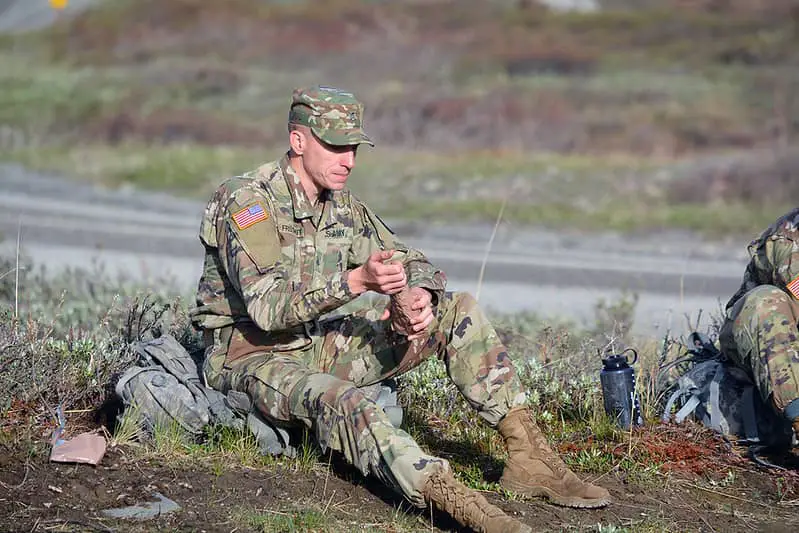
Toughening your feet for ruck marching comes from regular rucking and increasing ruck march distances. Conditioning your feet and performing exercises for the arch of your foot, ankle, and calf will help toughen your feet for ruck marching.
It goes without saying that practice makes perfect, this also goes for rucking. Body builders build up calluses under their fingers and on the top of their palms because of their constant handling of weights and dumbells.
The more you ruck, the more you expose your feet to tough rucking conditions. Whether that be from calluses or because you’ve identified the hot spots on your feet that are prone to blisters, the more you ruck the more you and your feet know.
With that said though, there are exercises that you can do on top of regular ruck marching to help condition your feet to the tough times and supplement your ruck marching performance.
Here’s how you toughen your feet for ruck marching:
1. Condition Your Foot Arch
2. Condition & Stretch Your Ankle
3. Condition Your Calfs
4. Use Rubbing Alcohol Before & After The Ruck
5. Avoid Wearing New Boots
6. Go Out & Ruck More
1- Condition Your Foot Arch
In the military, and during ruck marches, it is best practice to attend to your feet one foot at a time.
Soldiers in the military remove only one boot at a time to change their socks, medicate blisters and so on.
In order to condition your feet we highly recommend the golf ball method (source):
These conditioning exercises help you last longer during a ruck march which results in longer ruck marches and helps you toughen your feet for ruck marching.
Golf Ball Roll
The Golf Ball Roll method works on your Plantar Fascia Ligament which essentially runs from your heel to the top of your foot. It usually tires out during a foot march which causes tightness in this area and leads to the arch of the foot dropping (source).
Other common causes include:
- strecth fractures
- being overweight
Here’s how to relive foot arch pain and condition it through the golf ball roll method (source).
- Sit on a chair with both feet planted on the floor.
- Roll a golf ball under the arch of your affected foot for 2 minutes.
All you’ll need is a golf ball which can easily fit in your rucksack
2- Condition & Stretch Your Ankle
Conditioning your ankle is key when rucking. Especially if you’re rucking uphill, down hill, or on unstable terrain. This adds pressure to your ankle the entire time during a ruck.
Implementing the “Ankle Range of Motion” stretch will help elevate some of the pressure.
Here’s how to do it (source):
1- Sit down so that your feet do not touch the floor.
2- Use your foot to write each letter of the alphabet in the air. Lead with your big toe.
Here are some similar exercises and stretches from Apex Orthopedic Rehabilitation:
3- Condition Your Calfs
Performing the classic calf raised will strengthen your calfs which play a big role in rucking. Especially if you’re rucking on different terrains such as sand or uphill.
- Stand behind a chair with your weight evenly distributed over both feet.
- Lift one foot off the floor
- Raise the heel of your foot as high as you can, then lower it
- Repeat 10 times (source)
Here’s a visual demonstration by Physical Therapists Bob & Brad.
4- Use Rubbing Alcohol Before & After The Ruck
Rubbing alcohol can help toughen your feet as it dries out your skin and helps close the pores to prevent sweating. Rucking tip of the day, you always want your feet to stay dry during a ruck. Trust us, you don’t want soggy, smelly, and blister-full feet when you’re done with the ruck.
Rubbing alcohol insures that your feet stay dry, it prevents sweat and therefore prevents odor, this should also lessen the chances of you getting blisters from your ruck session.
Here’s how you should use alcohol before, during, and after your ruck session to toughen your feet:
- Grab a bottle of rubbing alcohol
- Pour it onto a cotton pad
- carefully rub the alcohol filled cotton pad all around your feet (make sure to get the hard spots like the gaps between your toes and any other sensitive spots)
- Let the alcohol evaporate by simply letting your feet air dry.
- If you have an extra pair of socks, put them on.
5- Avoid Wearing New Boots
While this is well known, it’s worth adding to the list as you really don’t want to be flexing your new boots to your friends when you have a competitive ruck march event. This is because most people need time to break into a new pair of boots to avoid getting ruck march blisters.
While blisters are a sign that you had a rough ruck, there is no proof to show that the more blisters you get the better the skin hardens. Research conducted by Brennan et al in 2012 reported, that troops who were in Iraq for 12 months who did not “break in” their boots were far more likely to suffer from blisters (source).
6- Go Out & Ruck More
This may seem obvious, but your feet are more prone to fatigue if you don’t ruck as often. If you’re rucking once a week, you may want to increase that to 2 or 3 sessions a week.
Practice makes perfect. Your feet need to be exposed to whatever environment you’re asking it to improve in. So if you’re looking for tougher feet for thos ruck marches, you need to ruck more often for the skin on your feet to get more comfortable to the harsh environments of a 10 20 or 30 mile ruck.
General Foot Care Best Practices to Toughen Your Feet For Rucking
Adhering to a foot care regimen will help you take care of your feet and help you ruck march for longer and toughen your feet in the long run.
Here’s what we recommend to take care of your feet for a Ruck March:
- Trim your toe nails
- Keep feet clean
- Use foot powder to prevent blisters
- Wear merino wool socks made for rucking
- Keep your feet and boot dry
- Wash your feet regularly
- Bring a boot insoles that you’re used to wearing
Preventing blisters from ruck marching is key to longevity, check out our full guide on how to prevent ruck march blisters.
Learn more about how much weight to carry when rucking and ruck marching to prevent rucking injuries and help you ruck march for longer.
These exercises are to be done before, during or after a ruck march. Learn more about what you should do before and after rucking.

